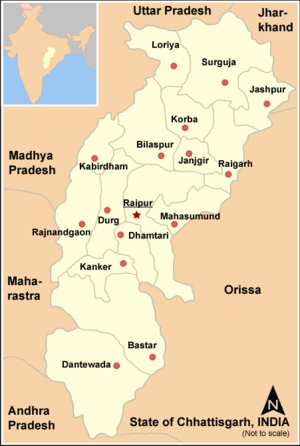Dandakaranya
Dandakaranya is a historical region in India, mentioned in the Ramayana. It is identified with a territory roughly equivalent to the Bastar division in the Chhattisgarh state in the central-east part of India. It covers about 92,200 square kilometres (35,600 sq mi) of land, which includes the Abujhmar Hills in the west and the Eastern Ghats in the east, including regions of Telangana, Andhra Pradesh, Chhattisgarh and Odisha states. It spans about 300 kilometres (200 mi) from north to south and about 500 kilometres (300 mi) from east to west.[1] Dandakaranya roughly translates from Sanskrit to "The Jungle (aranya) of Punishment (dandakas").[2] The Balaghat district of Madhya Pradesh and Bhandara, Gondia and Gadchiroli districts of Maharashtra are part of the ancient region Dandakaranya.

Etymology
Dandaka-aranya, means the Dandak Forest, the abode of the demon Dandak.[1] Dandaka (Sanskrit: दंडक, IAST: Daṃḍaka) is the name of a forest mentioned in the ancient Indian text Ramayana. It is also known as Dandakaranya, aranya being the Sanskrit word for "forest". It was the location of the Danda Kingdom, a stronghold of the Rakshasa tribes. It was state of the Lanka Kingdom under the reign of Ravana. Ravana's governor Khara ruled this province.
As a sacred land in Hinduism
Dandakaranya is considered sacred in Hinduism, as many accounts of the region describe ancient Hindu peoples and Hindu deities living together in refuge there. The Dandakaranya zone was the location of the turning point in the Ramayana, a famous Sanskrit epic. The plot for the divine objectives of the Hindu Trinity to uproot the rakshasa from the land was formulated here. According to the holy Ramayana, it was home to many deadly creatures and demons. Exiled persons resided here and sages had to cross it in order to reach the Vindhya Mountains. Rama, his wife Sita and his brother Lakshmana spent initial years of fourteen years as exiles traveling around the region. This region has an average height of metres and lies mostly in the Indian State of Chhattisgarh.[3]
See also
- Danda Kingdom
- Marichjhapi Massacre
References
- "Dandakaranya". Encyclopædia Britannica Online.
- "In the footsteps of Rama - The Pioneer". Archived from the original on 7 May 2016. Retrieved 22 April 2016.
- "Aranya Kand". Tulsi Ramayana. Archived from the original on 7 October 2008. Retrieved 6 January 2009.
.jpg)